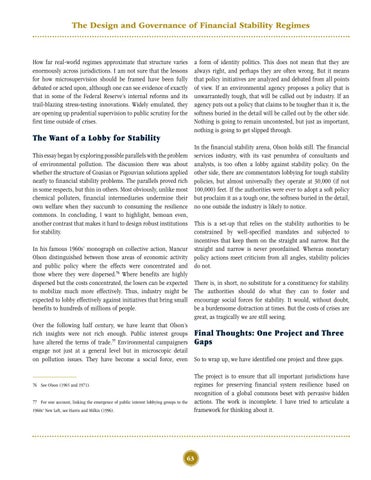The Design and Governance of Financial Stability Regimes
How far real-world regimes approximate that structure varies enormously across jurisdictions. I am not sure that the lessons for how microsupervision should be framed have been fully debated or acted upon, although one can see evidence of exactly that in some of the Federal Reserve’s internal reforms and its trail-blazing stress-testing innovations. Widely emulated, they are opening up prudential supervision to public scrutiny for the first time outside of crises.
The Want of a Lobby for Stability
a form of identity politics. This does not mean that they are always right, and perhaps they are often wrong. But it means that policy initiatives are analyzed and debated from all points of view. If an environmental agency proposes a policy that is unwarrantedly tough, that will be called out by industry. If an agency puts out a policy that claims to be tougher than it is, the softness buried in the detail will be called out by the other side. Nothing is going to remain uncontested, but just as important, nothing is going to get slipped through.
In the financial stability arena, Olson holds still. The financial This essay began by exploring possible parallels with the problem services industry, with its vast penumbra of consultants and of environmental pollution. The discussion there was about analysts, is too often a lobby against stability policy. On the whether the structure of Coasian or Pigouvian solutions applied other side, there are commentators lobbying for tough stability neatly to financial stability problems. The parallels proved rich policies, but almost universally they operate at 30,000 (if not in some respects, but thin in others. Most obviously, unlike most 100,000) feet. If the authorities were ever to adopt a soft policy chemical polluters, financial intermediaries undermine their but proclaim it as a tough one, the softness buried in the detail, own welfare when they succumb to consuming the resilience no one outside the industry is likely to notice. commons. In concluding, I want to highlight, bemoan even, another contrast that makes it hard to design robust institutions This is a set-up that relies on the stability authorities to be for stability. constrained by well-specified mandates and subjected to incentives that keep them on the straight and narrow. But the In his famous 1960s’ monograph on collective action, Mancur straight and narrow is never preordained. Whereas monetary Olson distinguished between those areas of economic activity policy actions meet criticism from all angles, stability policies and public policy where the effects were concentrated and do not. those where they were dispersed.76 Where benefits are highly dispersed but the costs concentrated, the losers can be expected There is, in short, no substitute for a constituency for stability. to mobilize much more effectively. Thus, industry might be The authorities should do what they can to foster and expected to lobby effectively against initiatives that bring small encourage social forces for stability. It would, without doubt, benefits to hundreds of millions of people. be a burdensome distraction at times. But the costs of crises are great, as tragically we are still seeing. Over the following half century, we have learnt that Olson’s rich insights were not rich enough. Public interest groups Final Thoughts: One Project and Three have altered the terms of trade.77 Environmental campaigners Gaps engage not just at a general level but in microscopic detail on pollution issues. They have become a social force, even So to wrap up, we have identified one project and three gaps.
76 See Olson (1965 and 1971). 77 For one account, linking the emergence of public interest lobbying groups to the 1960s’ New Left, see Harris and Milkis (1996).
63
The project is to ensure that all important jurisdictions have regimes for preserving financial system resilience based on recognition of a global commons beset with pervasive hidden actions. The work is incomplete. I have tried to articulate a framework for thinking about it.
